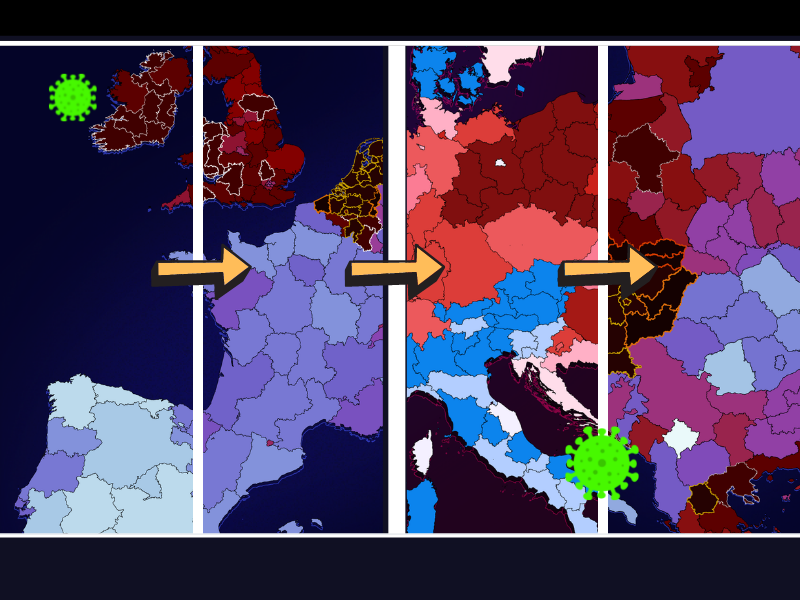
For some time now, our continent has been the scene of the largest corona hotspot on earth. Also this past week, the numbers have continued to rise unabated in most places. The end of November was marked by stricter measures for many countries, which means that, for the second year in a row, happy holidays and New Year’s Eve parties apparently have to be celebrated in (extremely) private circles. December 2021 is actually very similar to December 2020, except with vaccines and a more infectious coronavirus variant.
Why are the reins being tightened? All is not going too well in terms of the number of infections. This is leading to increasing pressure on hospitals and crematoria. In the last week of November, these were highest in Central Europe and the Low Countries. The figures were also the highest in the Czech Republic which, unlike its immediate neighbors Slovakia and Austria, decided not to completely lock down society. You can see the trends since the beginning of August on the following heat map.

Tighten things up or go down in flames
In some cases, these measures are specifically aimed at those who have been vaccinated, as in Germany, Portugal and Sweden. The Netherlands, Norway and Belgium prefer tightening measures that do not differentiate between vaccinated and unvaccinated people. In Greece, a mandatory vaccination for those over 60 will be adopted, and in France, starting next month, you can lose your status as a “fully vaccinated” person if you wait too long to get a booster shot.
On the slider chart, the figures from 25 November to 1 December have been placed next to the dates of last week and three weeks ago. This clearly shows how corona is continuing to spread like an oil slick. The situation is deteriorating at a rapid pace, especially in Poland, Switzerland and France.
The Netherlands and Belgium
More or less the same trend prevails in the Low Countries as they did last week. Limburg, Zeeland and the five Flemish provinces were among the continental leaders where incidences are concerned. These numbers have now risen to such an extent that the number of new infections on municipal maps is no longer expressed per 100,000 inhabitants, but rather as a percentage of the population.
Between 26 November and 2 December, more than 1 in 50 residents in some municipalities were notified that their coronal test was positive. The fact that the Netherlands shines a little brighter on this week’s map seems to be the result of inadequate testing capacity rather than response to actual measures.
Test until you drop
In the Netherlands, the number of new corona reports per 24 hours has been fluctuating at around 20,000 for some time now. Does this mean that the measures are bearing fruit? If the maximum testing capacity has been reached, the charts above may distort the actual picture to some degree. This is where the percentage of positive tests comes in.
The European Centre for Disease Prevention and Control (ECDC), in particular, is closely following these developments. The proportion of positive corona tests is in fact half of what determines the color assigned to a part of the country on the traffic light map. In an ideal situation, the proportion of positive tests should not exceed 5 % so that a targeted track and trace investigation can be conducted into the spread of the virus within a community. This approach plays a crucial role in Denmark and many East Asian countries, for instance.
That merely conducting a lot of corona tests is not enough to bring corona under control is something Austria is proving. The enormous testing capacity in place there could not prevent the fact that the pressure on hospital care is now unmanageable and a national lockdown needs to prevent any further escalation. What impact the lack of testing capacity has on hospitals in eastern Germany and Poland will most likely become clear over the next few weeks. A drop in the proportion of positive tests may be an indication that a peak is over its climax.
Yet there seems to be no sign of that anywhere here in Western Europe yet. Albeit, Romania, Bulgaria and the Baltic States seem to have the worst of it behind them. These were the percentages on a sub-national level between 22 and 28 November.

The booster race
Along with corona measures and an adequate test, trace & isolate policy, vaccines are a third vital line of defense in the fight against the rampant Delta variant. In order to be optimally protected throughout the winter, citizens here iin Europe are being invited to get a booster shot. Even so, this is not happening at the same tempo in all areas. The final animation shows how this has been proceeding since the beginning of September.
The Netherlands needed two months at the beginning of the year to make up for its sluggish start. At the start of the third month of the booster campaign, there still seems to be no sign of a race to catch up. Readers who would love to see the Dutch team win a European Championship should skip this race for now.

